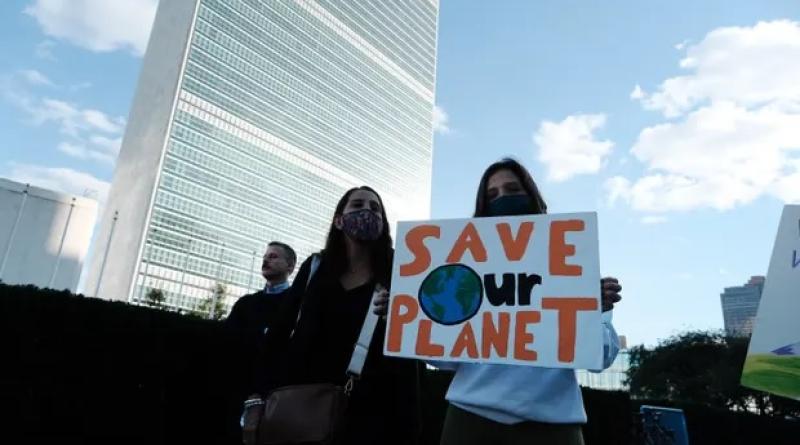The world is on the brink of breaching a critical climate threshold, according to a new study published on Monday, signifying time is running exceedingly short to spare the world the most catastrophic effects of global heating.
Using artificial intelligence to predict warming timelines, researchers at Stanford University and Colorado State University found that 1.5C of warming over industrial levels will probably be crossed in the next decade. The study also shows the Earth is on track to exceed 2C warming,which international scientists identified as a tipping point, with a 50% chance the grave benchmark would be met by mid-century.
“We have very clear evidence of the impact on different ecosystems from the 1C of global warming that’s already happened,” said Stanford University climate scientist Noah Diffenbaugh, who co-authored the study with atmospheric scientist Elizabeth Barnes. “This new study, using a new method, adds to the evidence that we certainly will face continuing changes in climate that intensify the impacts we are already feeling.”
Utilizing a neural network, or a type of AI that recognizes relationships in vast sets of data, the scientists trained the system to analyze a wide array of global climate model simulations and then asked it to determine timelines for given temperature thresholds.
The model found a nearly 70% chance that the two-degree threshold would be crossed between 2044 and 2065, even if emissions rapidly decline. To check the AI’s prediction prowess, they also entered historical measurements and asked the system to evaluate current levels of heating already noted. Using data from 1980 to 2021, the AI passed the test, correctly homing in on both the 1.1C warming reached by 2022 and the patterns and pace observed in recent decades.
The two temperature benchmarks, outlined as crisis points by the United Nations Paris agreement, produce vastly different outcomes across the world. The landmark pact, signed by nearly 200 countries, pledged to keep heating well below two degrees and recognized that aiming for 1.5C “would significantly reduce the risks and impacts of climate change”.
Half a degree of heating may not seem like a lot, but the increased impacts are exponential, intensifying a broad scale of consequences for ecosystems around the world, and the people, plants and animals that depend on them. Just a fraction of a degree of warming would increase the number of summers the Arctic would be ice-free tenfold, according to the Intergovernmental Panel on Climate Change, a global consortium of scientists founded to assess climate change science for the UN. The difference between 1.5C and 2C also results in twice the amount of lost habitat for plants and three times the amount for insects.
The change will also fuel a dangerous rise in disasters. A warmer world will deliver droughts and deluges and produce more firestorms and floods. Scorching heatwaves will become more severe and more common, occurring 5.6 times more often at the 2C benchmark, according to the IPCC, with roughly 1bn people facing a greater potential of fatal fusions of humidity and heat. Communities around the world will have to come to grips with more weather whiplash that flips furiously between extremes.
For many developing countries – including small island nations on the frontlines of the climate crisis – the difference between the two is existential. Some regions warm faster than others and the effects from global heating won’t unfold equally. The highest toll is already being felt by those who are more vulnerable and less affluent and the devastating divisions are only expected to sharpen.
Climate scientists have long been warning of the near-inevitability of crossing 1.5C, but by offering a new way of predicting key windows, this study has made an even more urgent case for curbing emissions and adapting to the effects that are already beginning to unfold.
“Our AI model is quite convinced that there has already been enough warming that 2C is likely to be exceeded if reaching net-zero emissions takes another half-century,” said Diffenbaugh. “Net-zero pledges are often framed around achieving the Paris Agreement 1.5C goal,” he added. “Our results suggest that those ambitious pledges might be needed to avoid 2C.”
The findings shouldn’t be seen as an indication that the world has failed to meet the moment, Diffenbaugh emphasized. Instead, he hopes the work serves to motivate rather than dismay. There’s still time to stave off an even higher escalation in the effects and prepare for the ones already brewing – but not much.
“Managing these risks effectively will require both greenhouse gas mitigation and adaptation,” he said. “We are not adapted to the global warming that’s already happened and we certainly are not adapted to what is certain to be more global warming in the future.”
And, while progress is being made on shifting toward a more sustainable future, there’s a long way to go. “Stabilizing the climate system will require reaching net zero, he said. “There are a lot of emissions globally – and it’s a big ship to turn around.”





